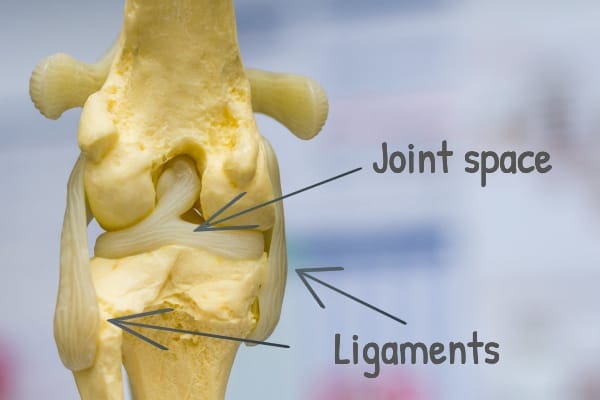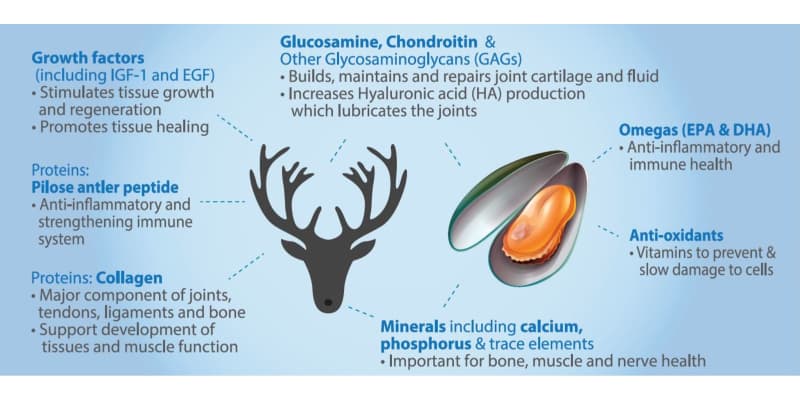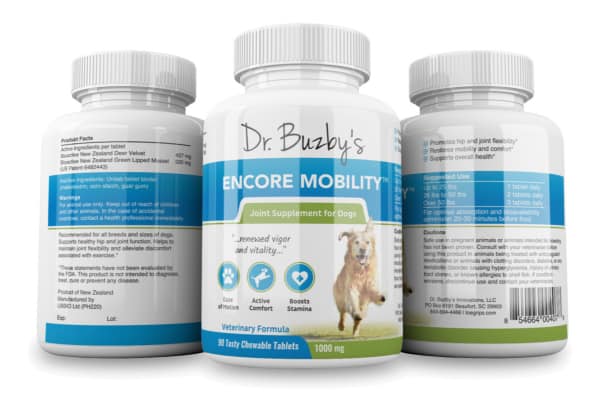If your senior dog is starting to show signs of aging, your vet may recommend a joint supplement for dogs. A quick search shows hundreds of options. How do you know which one to pick? Integrative veterinarian Dr. Julie Buzby shares collective thoughts from the veterinary community about joint supplements for dogs so you can wade through the marketing hype and choose products that will improve your dog’s mobility, happiness, and overall well-being.

Your beloved dog is getting older. She’s not as quick getting out the door, she naps a little more frequently, and she moves with a bit more caution and care. This isn’t too surprising. Even though age is not a disease, dogs usually slow down as they age. Arthritis settles into their joints, frequently causing joint pain.
If your dog shows signs of joint pain, there are thousands of products and treatments out there that claim to minimize discomfort and restore vitality. The truth is many products lack any real health benefit for your dog—and may even harm your dog if used improperly.
So today, I want to share my thoughts on joint supplements for dogs. From my experience as an integrative veterinarian for over 25+ years, supplements can be a vital part of your dog’s treatment plan for joint health and joint care. It’s important for you to know how to read a supplement label.
First, I’ll share how supplements work and then name eight supplements I most commonly recommend for my senior patients.
How do joint supplements for dogs work?
To understand how supplements work, a basic understanding of anatomy will be helpful—as well as knowing the causes of joint pain. We’ll also discuss why commonly prescribed medications may work best in “synergy” with supplements to help your dog live her best life now.
Joint anatomy in dogs
Joints are formed between two or more bones, the ends of which are lined with layers of cartilage to act as shock absorbers, provide a smooth surface for joint “gliding,” and transfer forces in the joint to prevent injury.
Cords of semi-flexible connective tissue called ligaments help stabilize most joints like your dog’s knees. Ligaments connect bone to bone (and function to “hold” joints together), while tendons connect muscle to bone and are not a part of joint anatomy.
There are several different types of joints in the body, and their structure correlates to their function.

Causes of joint pain in dogs
Joint disease can affect dogs of any age, but several underlying conditions make some dogs more susceptible to joint pain later in life.
- Genetics: Dogs can inherit genes that negatively affect the development of joints, causing early-onset joint pain and discomfort. This category would include genetic conditions such as hip dysplasia in dogs.
- Traumatic injuries: Traumatic injuries like a torn ACL in dogs or a ligament tear in the dog’s knee can cause inflammation and biomechanical changes, which cause limping and severe pain.
- Wear and tear: There is also joint wear-and-tear as your dog ages. Cartilage in the joint spaces tends to wear down faster than the body can replace or repair it. This can cause further joint inflammation and eventually lead to osteoarthritis in dogs.
Common medications for joint pain in dogs
Depending on your dog’s diagnosis, your veterinarian may recommend any number of treatments and medications to help relieve arthritis pain in dogs. Commonly, veterinarians may prescribe non-steroidal anti-inflammatory drugs (NSAIDS) because they target the inflammation associated with most joint diseases in dogs.
I’ve run across owners who don’t want to give pain meds because they will only “mask the symptoms.” While it’s true these medications cannot reverse arthritis, they are effective at managing the pain. Even if you choose surgical correction, over time, arthritis will return. Because arthritis can’t be cured, helping to manage the symptoms is essential for making sure our dogs remain comfortable as they age.
While NSAIDs are effective at relieving your dog’s pain, they are only a part of the multi-modal management of pain and mobility for aging dogs. Your dog may act years younger after starting an NSAID (and I commonly prescribe them because they help dogs feel so much better), but what your dog also needs is a little help in repairing and supporting cartilage.
Enter canine joint supplements…
8 joint supplements for dogs
In combination with NSAIDs, your vet may recommend a joint supplement to ease your dog’s discomfort. Joint supplements have clinically proven protective effects on the joints by addressing inflammation and contributing to cartilage repair. Supplements can also help slow the progression of cartilage breakdown and can have other remarkable effects throughout the body.

One important thing to note is that unlike NSAIDS, which can work overnight, joint supplements usually take four to eight weeks of use before reaching their full effect. Happily, they tend to have fewer side effects than most prescription pain medications for dogs.
Here are eight joint supplements for dogs you should consider discussing with your veterinarian:
1. Glucosamine/chondroitin
Glucosamine and chondroitin sulfate are the two most common active ingredients in hip and joint supplements for dogs. They are complex sugars called glycosaminoglycans (GAGs), one of the naturally occurring building blocks for cartilage in your dog’s body. They also inhibit the production of cartilage-destroying enzymes and inflammatory molecules that can hurt your dog’s joints and soft tissues.
Glucosamine and chondroitin protect existing cartilage by keeping it flexible and elastic. They are an integral part of the biochemical pathways in your dog’s body that are necessary to make new cartilage.
Glucosamine is in short supply when dogs have injuries and arthritis, so supplementing these elements may improve healing time. GAGs can also form a protective layer on the inside of your dog’s intestines and urinary bladder so that she is less susceptible to infection, toxins, and inflammation.
Supplemental glucosamine comes from the shells of crustaceans and bone meal in meat-based diets. Supplemental chondroitin can only come from animal cartilage, which makes it more expensive than glucosamine sources. It is essential to know the sources for GAG supplements because it will affect how your dog’s body absorbs GAGs. If the glucosamine and chondroitin are not harvested from optimal sources, your dog may not absorb the amount necessary to receive the health benefits.
2. Green lipped mussel (GLM)
Green lipped mussel is a shellfish that comes from New Zealand and is rich in GAGs like glucosamine and chondroitin.
According to some studies, green lipped mussel has an anti-inflammatory effect due to its ability to inhibit inflammatory mediators. It can also help with pain relief for dogs with osteoarthritis. This effect is further amplified when used in combination with other elements like deer velvet antler.
To learn more, check out our comprehensive article on green lipped mussel for dogs.
3. Methylsulfonylmethane (MSM)
Methylsulfonylmethane is a compound present in small portions of foods like grains, eggs, fruits, and vegetables. The MSM available in joint supplements contains sulfur that is more biologically active than what is found in regular dog food.
Sulfur is a critical element used by intestinal bacteria to produce methionine, which is an essential amino acid. Methionine:
- Prevents damage to the liver
- Produces melatonin, which helps your dog fall asleep
- Contains anti-inflammatory and pain-relieving properties
- Contributes to the formation of new cartilage
4. Deer velvet antler

Deer velvet antler is an element of traditional Chinese medicine that comes from the newly developed antler of a deer or elk. It is humanely collected from the deer, who goes on to live a normal life.
Deer velvet has been used in medicine for over 2000 years and provides a natural, holistic treatment for various chronic pathological conditions. It is the only quality renewable source of glucosamine, chondroitin sulfate, collagen, and hyaluronic acid. So, it’s no surprise that it was shown to provide pain relief from osteoarthritis in dogs in a scientific study. Deer velvet also boosts the immune system’s ability to fight infection.
I believe so strongly in the value of this ingredient, that I import my own brand of supplement called Dr. Buzby’s Encore Mobility Joint Supplement for Dogs, which contains both deer velvet antler and green lipped mussel, both sourced from New Zealand. This combination of ingredients is formulated into a highly palatable, soft chew tablet given as a dog treat. It is highly effective in helping dogs with arthritis and joint pain, but also helps renew my patients’ “vim and vigor.”
The benefits of Encore Mobility, a joint supplement for dogs that contains both deer antler velvet and green lipped mussel
The infographic below illustrates seven benefits found in Encore Mobility Joint Supplement for Dogs. This natural supplement pairs deer velvet with green lipped mussel for a powerful combined effect.

Ingredients in joint supplements can have other health benefits too. Check out my list of best supplements for joint pain in dogs for more detailed information.
Save 10% on Encore Mobility™ Joint Supplement for Dogs

Give your dog more good days.
Use promo code HAPPY to save 10% on Encore Mobility.
5. Turmeric/curcumin
Turmeric is a root related to the ginger family known as a flavoring and coloring agent in food. Curcumin is the active compound in turmeric and is a supplement in human medicine for painful and inflammatory conditions. In human studies, it protects against stomach, skin, and colon cancers. Turmeric also helps protect kidneys from damage due to toxins. When applied to tumor cells in a lab setting, it has been shown to stop the replication of tumor cells.
There are only a few studies available that discuss the benefits of turmeric and curcumin in dogs. However, one study published in Research in Veterinary Science in 2016 demonstrated that the anti-inflammatory effects of curcumin helped dogs with arthritis-associated pain.
6. Hyaluronic acid
Hyaluronic acid is also a type of glycosaminoglycan (GAG), but it has a larger molecular size than glucosamine or chondroitin. It is the main component of synovial fluid—a highly viscous liquid that helps to lubricate joints.
Hyaluronic acid is vital in wound healing and makes cartilage more resilient to wear and tear by coating the tissue. As dogs age, the concentration of hyaluronic acid in the body decreases and makes dogs more susceptible to joint pain. This explains why older dogs with skin wounds take longer to heal than younger dogs. Topical ointments containing hyaluronic acid are useful in a variety of skin conditions.
One study on hyaluronic acid compared to traditional conservative treatment is published on the National Institute for Biotechnology Information’s website. It found significant improvement of joint pain when the joint spaces received direct injections of hyaluronic acid in arthritic dogs with hip dysplasia. This technique has been used in racehorses for decades and is now commonplace in human medicine.

7. Omega fatty acids
Fatty acids are essential components of the cells in your dog’s body. The benefits of omega-3 fatty acids for dogs are numerous, but the body does not naturally produce them. Instead, your dog’s diet must provide them. This is why they are called “essential fatty acids.”
Most commercial dog foods have low quantities of omega-3s, and they may be damaged in the process of manufacturing the food, which typically happens at high temperatures. So your dog may need an additional omega-3 supplement.
Fish oil
Fish oil is a terrific source of two omega-3 fatty acids: eicosapentaenoic acid (EPA) and docosahexaenoic acid (DHA). (And yes, fish is more beneficial than a plant-based source, like flax seeds.) EPA and DHA reduce inflammation that affects soft tissues such as the intestines, the urinary bladder, and specifically the joints. These fatty acids also promote heart health and may reduce the size of tumors via cell differentiation.
Years ago, two scientific studies suggested that dogs with chronic osteoarthritis who were fed omega-3 fatty acid supplemented diets demonstrated improvement in their pain level and arthritic conditions. I’ve been a fan ever since and recommend it for virtually every one of my patients.
Like most supplements, fatty acids come in a variety of forms—chews, liquid, and capsules. But unlike most supplements, storage conditions matter a lot. Be sure to store the bottle properly, preferably in the refrigerator. Light, heat, and air can oxidize fatty acids, causing harmful free radicals to form, which gives the product a rancid, fishy smell. Always store omega 3s at temperatures less than 80 degrees.
Nordic Naturals is the brand I recommend to my clients. This ethical company makes the Nordic Pet Collection, featuring Omega-3 Pet™ which comes in liquid and soft gel capsules. These supplements are formulated from EPA and DHA harvested from cold-water fish—specifically wild anchovy and sardines.
8. CBD
Cannabidiol, or CBD, is a derivative of the Cannabis or hemp plant. CBD does not contain the psychoactive ingredient known as THC which is toxic for dogs.
CBD oil has become very popular recently for its use in supplements that alleviate pain, inflammation, and anxiety in dogs. Most of the research on CBD surrounds human medicine and its use for pain relief, glaucoma, seizures, and chemotherapy side effects.

While there are studies being conducted on the use of CBD oil for dogs, I still caution pet parents to be very careful using it. Regulation of these products can sometimes be a bit dicey, and there may be safety concerns with improper use.
There is abundant anecdotal evidence to suggest that CBD can be effective when used for dogs with anxiety and arthritis pain. However, it’s important to remember to always use CBD under your vet’s supervision since there is a risk of side effects.
What to look for in a joint supplement for dogs
Unfortunately, unlike prescription and over-the-counter medications that are regulated by the FDA, so-called “nutraceuticals” have less regulatory oversight. This not only means the market is flooded with products, it means not all products are equally effective or safe.
So how do you choose what joint supplement to give your dog?
1. Ask your veterinarian about a joint supplement for your dog.
Before you give your dog ANY over-the-counter medication, supplement, or even food if you’re not absolutely sure it’s safe and healthy, ask! I would rather answer questions about products until I’m blue in the face than to treat a dog for a preventable toxicity. Your vet has likely treated many patients with osteoarthritis and will have an opinion based on experience about which one is best for your individual dog.
2. Look at the ingredients on the supplement label.
Just like I investigate food labels to make sure my dogs are getting the vitamins and minerals they need, I always verify the ingredients of any supplements they get. Now that you’re more familiar with which ingredients may be most beneficial in a joint supplement, start checking out labels. Make sure they have “the good stuff” in them.
3. Research the company that manufactures the supplement.
Make sure the company that produces the supplement is legitimate. They should have a functioning website that has accessible data on the product.
Check for veterinary involvement
I am of the opinion that any company that is manufacturing medications or supplements for animals should have a relationship with a veterinarian, or have at least one veterinarian on staff. I trust my colleagues to make sure that products they put their names behind are safe and effective. If the company’s website doesn’t explicitly state their veterinary involvement, they should provide contact information for you to ask.
4. Don’t be fooled by online dog supplement reviews!
If you’re like me, when you’re researching something new to buy, you check out the reviews on sites like Amazon or other retailers. While this may be ok for buying a new pair of pants, it’s not enough information to form a decision on what joint supplement to give your dog. It is so easy these days to pay for fake reviews, they can’t always be trusted.
Similarly, watch out for buzz words like “natural” and “anti-aging.” Remember that these supplements are not regulated by the FDA, and there’s no oversight for what a product has to prove in order to use those types of labels.

Joint supplements for dogs can make a world of difference
Joint supplements not only amplify the pain-relieving effect of NSAID medications, but they also have fewer side effects and may decrease the amount of medication necessary to relieve inflammation. When I meet a new patient who has come to see me for acupuncture to address joint pain, the very first thing I do is start that dog on a joint supplement, sometimes a combination of them.
There are many joint supplements available on the market to help your dog live a happier life, so talk with your veterinarian about their recommended products for your furry friend.
Keep in mind many of the best supplements will have a combination of the ingredients I’ve listed above. This way, you don’t have to give your dog so many products every day.
However, remember the principle of multi-modal pain and mobility management for senior dogs. Most of my patients are on a “cocktail” of supplements plus traditional western medications. This is because they work together to provide a syngergistic effect and maximum comfort to boost quality of life. Talk to your veterinarian about what’s best for your dog.
What questions do you have about choosing a joint supplement for your dog?
Please comment below.


I know for humans with arthritis there are creams that can rubbed across the painful joints.
Is that true for dogs as well? 🤔
Hi Lexy,
Topical treatments for dogs are a bit tricky because they tend to try and lick them off. I am not aware of a cream that is good for canine arthritis. Thanks for asking this great question!
Hello,
we have a 9 year old West Highland terrier. We got her from a local SCPA a few years ago and don’t know too much of her background, other than that she was severely neglected.
Our ver noticed last year that she’s experiencing some hip discomfort and did recommend Movoflex. While it does seem to be helping, I’ve noticed our poor dog is still occasionally struggling to get up or even walk up from the porch into the house.
Our vet did recommend considering monthly injections to help with the arthritis, but in your experience, is that the only option and are there potential risks involved? We want our dog to feel a hundred percent all the time, but some days she is struggling and we’re doing our best ro keep her comfortable.
Hi James,
I am sorry your pup is having so much trouble with arthritis pain. She is lucky to have someone like you advocating for her health and well-being. While injections such as Adequan can be very helpful there are many other options as well. I will attach links to other articles with more information. I am hopeful you will find the right combination of therapies to get your sweet girl feeling her best. Wishing you all the luck for many happy days ahead.
1. Natural Pain Relief for Dogs: 13 Methods
2. Adequan for Dogs: Don’t Just Treat Arthritis, Slow it Down
3. How to Relieve Arthritis Pain in Dogs: The Ultimate Guide
4. Osteoarthritis in Dogs: Everything You Need to Know
I have a 2 Year old Lab, he was diagnosed with mild elbow dysplasia at 9 months, he did not require Surgical Intervention and was prescribed MetaCam 40mg (he’s a big boy), I also give him a Glucosamine/Chrondroitin Supplement daily
How long can he take the NSAIDS for, he still has stiffness and discomfort when rising from rest, but is generally very mobile once he is moving about, are there other supplements you would recommend ?
Hi Karl,
I am sorry your big guy is struggling with elbow pain. There are many dogs that take NSAIDs long term, but I do not usually recommend this for younger pups like yours. Pain medications are just a band-aid, and for younger dogs I would rather try to fix the actual problem. It might be a good idea to have your dog evaluated by an orthopedic specialist. They can let you know if surgery is a better option that medical management. Rehabilitation and physical therapy are also great therapy choices. As for supplements and other treatment options for arthritis pain, I will attach links to other articles with more information. I am hopeful you will be able to find the right combination of things to restore your young boy’s quality of life. Wishing him a long and happy future!
1. Natural Pain Relief for Dogs: 13 Methods
2. How to Relieve Arthritis Pain in Dogs: The Ultimate Guide
3. Adequan for Dogs: Don’t Just Treat Arthritis, Slow it Down
4. Osteoarthritis in Dogs: Everything You Need to Know
try extent joint supplement it’s kind of expensive but it works and my dog likes the taste of the powder mixed in a little water or food
I have a 8yr old pittie and she has recently torn her cruciate ligament. She’s not limping anymore, definitely walks slower some days when she goes for a walk. Her mobility is limited due to her knee, but it doesn’t seem to bother her too much anymore. Her Dr prescribed Carprofen for two weeks and it definitely helped. He did recommend surgery but I’d like to put her on supplements to see if that will help too.
I had her on a fish oil for her skin but also for her joints and it didn’t help her skin but she didn’t seem to be in much pain on her walks. I used to be a vet tech so I know about the difference between the supplements but that saying “nurses don’t make the best patients” lol so I haven’t decided what’s a good one for her.
Hi Kyla,
Of course, I am a big fan of Encore Mobility! I think it would be a great addition to the fish oil you are already using. I also really like Nutramax products and have had great success with Dasuquin Advanced. There are also other ways to help reduce pain and inflammation. Here is a link to another article with more information: Natural Pain Relief for Dogs: 13 Methods
Hoping that helps a bit. Wishing you and your senior girl a happy future together!
I’m so glad you approve of Dasuquin advanced with MSM. My Pug has been on it for the entire 7 years since I adopted him from a shelter, purported at that time to be between 4 and 5 years old. X-rays revealed that he was born with a small femur head in his right hip that does not fit snugly into the socket, and revealed that he had the very mild beginning of arthritis. In addition, his vet also prescribed a product called Omega Benefits which he also receives daily in his evening meal. He is now somewhere between 10 and 13 and, while he no longer likes to take long walks around the entire neighborhood, he enjoys walking the perimeter of our large yard several times a day. He “asks” for a boost sometimes to get up onto the sofa and is not real fond of steps anymore, but does not limp or favor his right rear leg at all.
Hi Sandie,
What a blessing your Pug has been doing so well over the past few years despite his hip abnormality. Yes, I have used Dasuquin Advanced in my own dogs and love Nutramax products because they are one of the few companies that actually put in the time and money to test their products to ensure they deliver the expected results. It sounds like you are doing a great job with your senior guy. I am certain he is loving life and living it to the fullest. Thanks for sharing your experience with us. Take care and keep up the good work!
Hi, my 13 year old Beagle takes Carprofen every other day and also Dasaquin Advanced on a daily basis. I would love to try your Encore Mobility supplement but am on a limited income. Could I drop the Dasaquin in lieu of the Encore or would i need to give him both?
Hi Fred,
This is a great question! I think it would be best to discuss the supplement options with your vet. Dasuquin and Encore Mobility have very different ingredients and therefore help with different pathways of pain, inflammation, and joint care. They can be used together but I am not sure which would be of most benefit for your dog when used alone. Of course, I think Encore Mobility is great, but each dog is different, and your vet will know more about your pup’s specific needs.
I have several joint supplements ( PetJoy, Juve Flex, Extend, and Nutra Thrive). I give 2 of my dogs Extend, once a day. One of my dogs had cancer and had one rear leg amputated. I also give her 2 Gabapenton 300 mg, daily. She is 13 years old. Will it hurt to give her one of the above joint supplements, in addition to the Extend and Gabapenton?
Hi Pamela,
I am glad you are looking for additional ways to help reduce your senior girl’s joint pain. I am not familiar with all of the available brands of supplements as there are far too many to research them all. In general, as long as you aren’t doubling up on the same ingredients across several different supplements you should be ok. With that being said, I always recommend you talk to your vet before adding something to your dog’s diet or treatment plan. Your vet is more familiar with your dog’s specific situation and needs and can let you know if something should be avoided. Wishing you the best of luck!
Thank you for this article! Checking out your Encore Mobility now!
My senior has arthritis really bad, to the point where brushing him is even uncomfortable for him, so, our vet prescribed an NSAID (Rimadyl). However, my pup also has really high liver counts and inflammation there, which means I hate to give any medication that the liver would have to really work on to process. Any recommendations for alleviating arthritis pain while being gentle on the liver? Or would supplements really be our best bet?
Thank you for all you do!
Hi Nikki,
I am glad you are searching for pain relieving options for your senior pup. Supplements are great and a vital part of treatment but there are many other choices to consider as well. Here is a link to another article with great informaion: How to Relieve Arthritis Pain in Dogs: The Ultimate Guide
Besides supplements, there are medications such as gabapentin or tramadol. You can also talk to a veterinary rehabilitation/physical therapy specialist who might be able to give you guidance on exercises to do at home to help decrease pain and inflammation. Laser therapy works wonders for arthritic dogs and acupuncture can help too. I hope you find the answers you need to give your sweet boy the best quality of life possible. He is lucky to have you advocating for his health and wellbeing!
Curious as to what you’d recommend for 12 yr old golden on carprofen 75 mg 2x a day. Thinking if switching to derramax 60 mg day. Scared of syde effects snd kidney damage. What supplements would you recommend
Hi David,
If you are wanting to switch medications, it might be a good idea to talk to your vet about Galliprant. It is a medication specifically for canine osteoarthritis and is supposed to be safer for the kidneys than other NSAIDs. Sometimes instead of changing medications, your vet may want to add on an additional medication. Some options would be gabapentin, tramadol, or possibly amantadine. As far as supplements go, I really think your dog would benefit from Encore Mobility. I have also used Dasuquin Advanced in my patients with great success. No matter what you choose, please make sure to include your vet in this decision-making process. They know your pup’s medical details and can steer you toward a good fit for your dog. Best wishes and good luck!
My 3.5yo rescue has bilateral torn CCL’s and concomitant kidney disease. I have limited his supplements because of his kidneys but do give him Nordic Naturals oil daily. What else would you recommend ? I know he is hurting but his kidneys are not doing their job.
Thank you for any suggestion.
Hi John,
I am glad you are advocating for your pup’s health and wellbeing. Since I haven’t examined your dog myself, I can’t make specific recommendations. To my knowledge, all the supplements listed in the article are safe for dogs with mild kidney dysfunction. Also, there is a medication specifically for canine osteoarthritis pain called Galliprant. It is supposed to be safer for the kidneys than other NSAIDs or anti-inflammatory medications. You can also look into physical therapy/rehabilitation. There are many exercises and treatments (like laser therapy) that could be helpful in reducing your dog’s pain level without using medications. I hope you can find the answers you are looking for to make the best choices for you and your sweet boy.